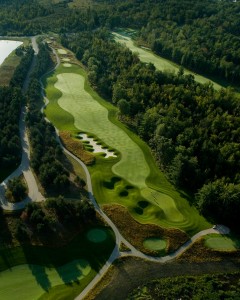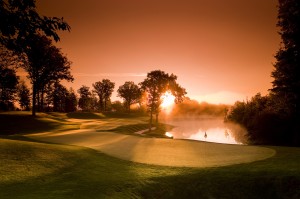
Tullymore Golf Course
Shortly after opening in 2002, Tullymore was named the number one new upscale public course in America by Golf Digest. With that kind of rookie year distinction, it’s easy to see why golfers keep coming back to this challenging course set amongst the pure, raw landscape of the Michigan wilds.
Designed by the highly acclaimed Jim Engh, this par-72 course has also been ranked amongst the top 15 of the 100 Greatest Public & Resort Courses in America by Golf Digest on more than one occasion.
With subtle undulations, the Tullymore course meanders through over 800 acres of woods, meadows, and wetlands. Greens are uniquely varied in both shape and size, and multiple sets of tees allow you to adapt play to your skill level. The course features five par-3 holes and five par-5 holes.
Tullymore Practice Facilities
Warm up before conquering the challenges of Tullymore on a generously sized driving range. With space for 22 golfers on the range, there is also a separate area for chipping and putting practice, ensuring your short game is as strong as your long.
Architect
Jim Engh is the genius behind Tullymore Golf Club’s challenging 18-hole course. He is one of only five living golf designers who have courses listed in Golf Digest’s Top 50 Greatest Courses in America. The renowned golf publication also named him as Architect of the Year in 2003. Another crowning achievement came from Golf World magazine when it named him one of the 25 Hottest Golf Architects in the World.

Engh’s acclaimed career in professional golf course design stretches over more than two decades. As projects in Asia and the U.S. were completed recognition of his work continued to grow and grow. Engh started his own firm in 1991 after honing his craft under such distinguished architects as Dick Nugent, Ken Dye, and Joe Finger. He also served as director of golf course design with the legendary British firm, Cotton Pennick.
A Golf Digest article quotes Engh as saying, “I know we have to please golfers the first time out, but I also try to design other levels into our courses so that you’ll learn something new about every hole every time you play it.” Tullymore is a testament to Engh’s statement – it is a course that golfers want to play again and again.
Pro Pointers: Hole By Hole
#1 Great opening hole that will take three shots for most golfers. The white birch is a great target off the tee. To reach the bunker from the silver tees it is 296 yards, from the black 281 yards, from the blue 241 yards, from the white 188 yards and from the gold 146 yards. Your second shot should favor the left side of the fairway for a better angle into the green. Par is a nice start. The depth of the green is 26 yards.
#2 A challenging par four will greet you on the second hole. The fairway bunker on the right is 335 silver tees, 277 from the black, 269 from the blue, 228 from the white, and 200 from the gold. Your second shot on the hole needs to be very precise. This second green is narrow, but is 40 yards deep. Club selection is very important.
#3 To look at the scorecard you would think easy par, but don’t be fooled by the yardage. Even though the hole is short you need distance off the tee to get by the oak trees on the right. Stay to the left side of the fairway. The distance to the bunker on the left from the tees is as follows: Silver is 277 yards, black is 273 yards, blue is 244 yards, white is 201 yards, and gold is 166 yards. The green is only 16 yards deep, but the hill behind the hole will work as a backdrop.
#4 The fourth hole is the first of five great par 3’s at Tullymore. Check the wind, it usually will be helping. When the hole location is back right take one extra club.
#5 Back to back par 3’s are unique, although found at some great golf courses such as Cypress Point. This hole plays slightly downhill so it will play 5-7 yards shorter. A back hole location is tough to get to. The green is 36 yards deep.
#6 This unique dogleg right par four gives you many choices off the tee. To clear the hazard (going at the pot bunker) from the silver tees is 217 yards, black 177 yards, blue 170 yards. To carry the pot bunker it is 273 yards from the silver, 233 from the black, 225 from the blue, 177 from the white, and 132 from the gold. The second shot is not long, but needs to be accurate. If the hole location is in the front or in the center play to the front left portion of the green and the ball will feed to the right. The green depth is 32 yards.
#7 The challenge of #7 is getting on the right plateau of the green. The wind can play havoc with your shot. The green depth is 47 yards.
#8 One of many things that Tullymore will be known for is it’s long par 5’s, eight is the first of those long par 5’s. A very generous landing area allows you to swing away. Big hitters who want to go for the green in two should stay to the right side of the fairway. They will then have to negotiate a shot just right of the two large pine trees and carry the marsh that lies behind the pine trees. Those of us playing the hole the conventional way still need to stay long and left to avoid the pine trees, and the marsh. This will set up a fairly easy shot into the green. The green depth is 34 yards.
#9 This is also a hole that you don’t see very often. A short par four that requires power off the tee. You need to get past the corner of this dogleg left to see the green. This will be your typical blind Irish shot to the green. Don’t be afraid to bring out your driver. There is a combination fairway/greenside bunker that starts 60 yards out on the left side, this bunker is named Patrick’s Purgatory, looks like heaven, but you don’t want to be in it. If the hole is in the center of the green you can take the bunker out of play by hitting the ball to the right side and letting it feed to the left. The green depth is 18 yards.
#10 The tenth hole is the start of some tremendous golf holes to come. If you like a hole that is challenging , but beautiful, you are on the right hole. Ten is a dogleg left that requires a fade off the tee. The right side is the spot to come into the hole from. Jim Engh has given you a run up area on the right hand side, to run your ball onto the green. Everything will feed to the left if you hit it in the run up area. The green depth is 30 yards long.
#11 One of my favorite two holes on the golf course. Don’t mess with the bunker on the left, unless you want bogey or double bogey. To carry the bunker from the silver is 229, black 205, blue 201, white 155, and gold 109. To reach the bunker straight away, which should be your target, is silver 280, black 256, blue 252, white 206, and gold 160. The fairway is very wide just short of the bunker. The green is cut into the hillside with almost an amphitheater feeling. Green depth is 37 yards. Make sure to check the view from the tee looking back to #10.
#12 This is a hole that will be long talked about. This hole is similar to one of the most famous holes in Ireland, The Dell hole at Lahinch Golf Club, where part of the green is hidden by the hillside. Twelve is similar but the green is much wider, 50 yards. My advice here is long will not hurt you with the hill behind the green. Enjoy the view looking back from the green. The green depth is 31 yards.
#13 The second of the long par 5’s. Only the longest hitters will get to this hole in two. A very generous landing area, especially for those who wish to carry the bunker. The carry is 230 yards from the silver. Black 185, blue 176, white 124, and gold 94 yards. The second shot should be left center of the fairway. Beware of the monster bunker in front of the green. The green depth is 31 yards.

#14 The fourteenth hole will give you three choices off the tee. 1. Go right of the fairway bunker and use the hill to kick your ball left. 2. Carry the bunker. To carry the bunker it is 247 from the silver, 196 from the black, 191 from the blue, and 155 from the white. 3. Go left of the oak tree, which is only for the big hitters. From the silver it is 294 yards, from the black 244 yards, blue 239, and white 211 yards. The second shot is one that needs to be hit solid. If you are to error to one side, make it right. The slope will kick the ball back towards the green. There is a pond that guards the left side of the green. The depth of the green is 33 yards.
#15 Like all par 3’s, club selection is important, but the wind and hole location can greatly affect your club choice. The green is 47 yards deep.
#16 This is truly a three shot hole as the yardage indicates. The driving area is wide, but beware of the hazard on the left. Your second shot is to a very wide fairway, which sets up the all-important third shot. Get your yardage and swing with confidence. Green depth is 33 yards. Enjoy the view looking back from the green.
#17 A short par four that is once again set up by a good drive. To cary all the hazards on the right, from the silver and black you must carry it 239 yards, blue 208, and white 201 yards. To carry the hazard straight away is much shorter. It is 161 yards from the silver and black tees, 136 from the blue, and 129 from the white. The green depth is 31 yards.
#18 Truly a great finishing hole. This is one par five that offers the opportunity to go for it in two. The drive must be hit solid. The following are carries from the tees: Over the right bunker, silver is 225, black is 180, blue is 167, and white is 100 yards. Over the water between the bunkers is 234 from the silver, black is 190, blue 176, and white is 101. To carry the left bunker silver is 283, black is 240, blue is 227, and white is 148 yards. Well now, if you have pulled off that great tee shot, you have to make a decision to go for it or not. If you hit to the run up area on the right, the green will feed your ball to the left. Green depth is 40 yards, but don’t be fooled by the fact that it is a shallow green in spots.